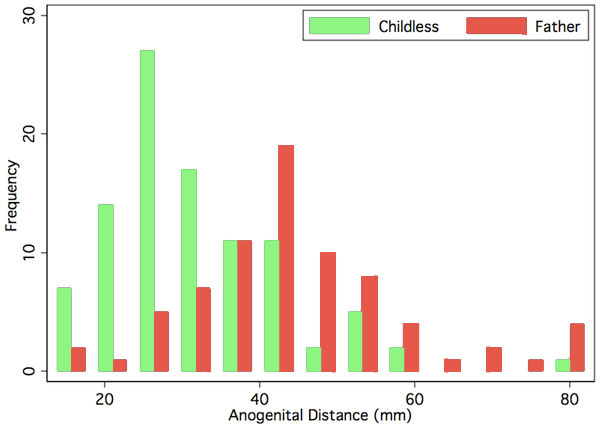File:Human male anogenital distance graph.jpg
Human_male_anogenital_distance_graph.jpg (600 × 429 pixels, file size: 28 KB, MIME type: image/jpeg)
Human Male Anogenital Distance Graph
Distribution of anogenital lengths in men that were childless and being evaluated for infertility and men with proven fertility.
Anogenital Distance (AGD) is a clinical measurement of a parameter that is sexually dimorphic for genital development. This distance, from the posterior aspect of the scrotum to the anal verge, has been used as a marker for endocrine disruption in animal studies and may also be shorter in infant males with genital anomalies.
This recent study in humans has shown that infertile men possessed significantly shorter mean AGD than fertile men.
- "A total of 117 infertile men (mean age: 35.3±17.4) and 56 fertile men (mean age: 44.8±9.7) were recruited. The infertile men possessed significantly shorter mean AGD and PL compared to the fertile controls (AGD: 31.8 vs 44.6 mm, PL: 107.1 vs 119.5 mm, p<0.01). The difference in AGD persisted even after accounting for ethnic and anthropomorphic differences. In addition to fatherhood, on both unadjusted and adjusted linear regression, AGD was significantly correlated with sperm density and total motile sperm count. After adjusting for demographic and reproductive variables, for each 1 cm increase in a man's AGD, the sperm density increases by 4.3 million sperm per mL (95% CI 0.53, 8.09, p = 0.03) and the total motile sperm count increases by 6.0 million sperm (95% CI 1.34, 10.58, p = 0.01). On adjusted analyses, no correlation was seen between penile length and semen parameters."
Original file name: Figure 2. Journal.pone.0018973.g002.png (original graph was black and white, added colour for each data point)
Reference
[Eisenberg ML, Hsieh MH, Walters RC, Krasnow R, Lipshultz LI. The Relationship between Anogenital Distance, Fatherhood, and Fertility in Adult Men. PLoS One. 2011 May 11;6(5):e18973. PMID:21589916 | PMC3092750 | PLoS One.
Citation: Eisenberg ML, Hsieh MH, Walters RC, Krasnow R, Lipshultz LI (2011) The Relationship between Anogenital Distance, Fatherhood, and Fertility in Adult Men. PLoS ONE 6(5): e18973. doi:10.1371/journal.pone.0018973
Editor: Joerg Gromoll, University of Muenster, Germany
Received: January 4, 2011; Accepted: March 22, 2011; Published: May 11, 2011
Copyright: © 2011 Eisenberg et al. This is an open-access article distributed under the terms of the Creative Commons Attribution License, which permits unrestricted use, distribution, and reproduction in any medium, provided the original author and source are credited.
File history
Click on a date/time to view the file as it appeared at that time.
| Date/Time | Thumbnail | Dimensions | User | Comment | |
|---|---|---|---|---|---|
| current | 09:48, 5 June 2011 |  | 600 × 429 (28 KB) | S8600021 (talk | contribs) | Distribution of anogenital lengths in men that were childless and being evaluated for infertility and men with proven fertility. Anogenital Distance (AGD) is a clinical measurement of a parameter that is sexually dimorphic for genital development. This |
You cannot overwrite this file.
File usage
The following page uses this file:
